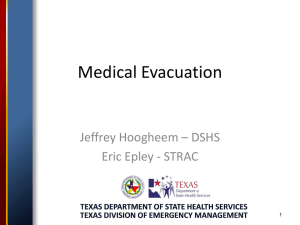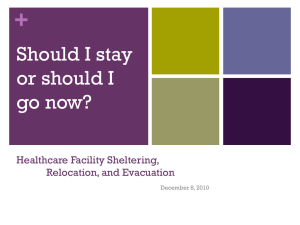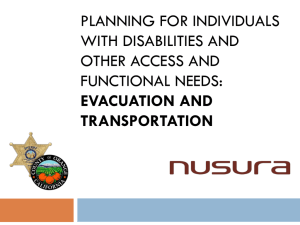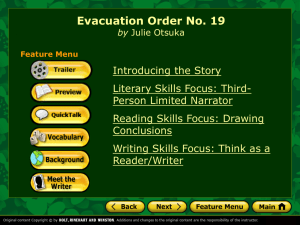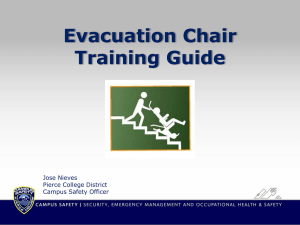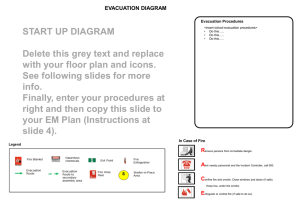Healthcare Facility Sheltering, Relocation, and Evacuation (PPT
advertisement
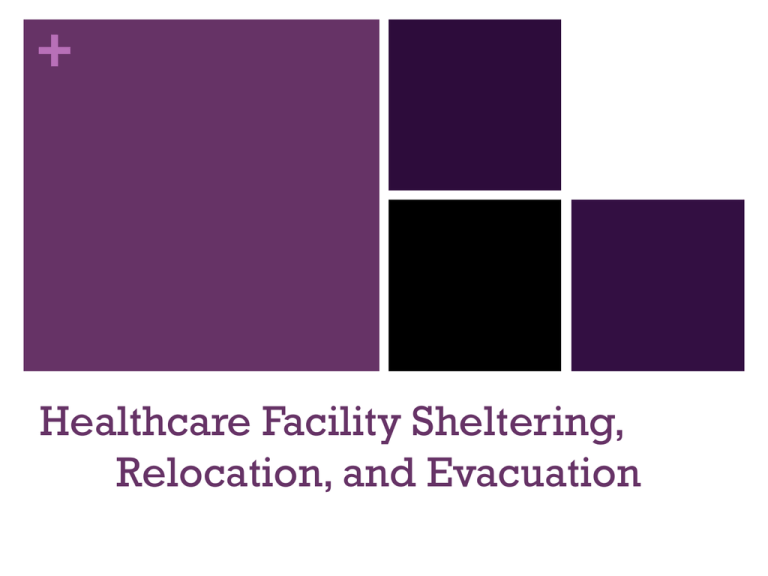
+ Healthcare Facility Sheltering, Relocation, and Evacuation + Healthcare Facility Sheltering, Relocation, and Evacuation Developed because a need as seen in recent events Team Effort!! + The Team John Hick MD - HCMC/MDH Don Sheldrew - MDH Janice Jones - MDH Carol Sele - NW RHPC Eric Weller – SC RHPC Chris Chell – Metro RHPC Julie Johnson – SW RHPC Cheryl Stephens – NE RHPC Chuck Hartsfield – Central / WC RHPC Katherine Grimm – Healtheast Care System Donna Blomquist – Metro RHPC Mark Lappe – Metro RHPC Angie Koch – SE RHPC / MDH Pam Schultz – Children's Hospitals and Clinics of MN + Background – Stuff Happens Recent Events 2009 – Red River Floods Meritcare Eventide 2010 Hospital Evacuation Nursing Home and Assisted Living – New Richland Nursing Home Evacuation Other less well known possibilities that almost happened + Issues Inconsistent Differences and confusing terminology between hospital and long-term care settings Lack of standardized decision-making regarding evacuation Lack of standardized processes and tagging/tracking of patients Inconsistency regarding the types and quantity of information sent with the patients Product for both Hospitals and LTC facilities + Decision making How When Triggers Who to call When to call Roles and responsibilities + Decision making Who has authority Command Unit decisions based decisions Command responsibility + Terms / Definitions Urgent / emergent Shelter in Place / Evacuation Relocation?? Full – where’s that fit? or partial evacuations + Triggers Types of incidents Threat to patients / residents Time / duration / proximity… + Patient Triage Who’s going Who’s going when Who’s going where Room clear Is standard triage assumed or should there be alternatives + Patient / Resident Tracking Floor / unit to triage or other unit Transport Facility to facility Multiple facilities + What to send Documentation – how much Medical necessities – meds / durable medical supplies Personal Lots Items? of Questions regarding the previous slides! + Process Reviewed existing plans – Central region template already in use and contained key structural elements Defined new terms Refined and re-wrote plan sections Introduced decision algorithm Developed job aids and tag recommendations + Process Introduced to RHPC’s and others for comment and feedback Developed training materials Ongoing process – review and modification as needed Availability – how and when + Plan Specifics Template – not proscriptive – must be adapted to institutional needs however facilities should not change definitions or base organization in order to maintain consistency + Terminology – Shelter in Place Shelter in place - Shelter In Place assures the maximal safety of individuals in their present location when the dangers of movement exceed the relative risk from the threat or movement cannot be safely completed in a reasonable timeframe + Terminology - Relocation Relocation - movement of patients to an area of relative safety in response to a given threat or movement to staging areas within the institution in preparation for evacuation. -Horizontal - movement to a safe location on the same floor, preferably nearer to an emergency exit -Vertical - movement of individuals to a safe location on a different floor when a horizontal evacuation cannot meet the service or safety needs of the patients or is unsafe + Terminology - Evacuation Evacuation - movement of patients out of the affected facility when the facility cannot maintain a safe environment of care. Evacuations may be emergent (fire or other immediate life safety threat) or non-emergent (delayed life-safety threat or anticipated evacuation) + Evacuation – Complete or Partial Complete evacuation – complete evacuation of a facility due to an unsafe environment of care – usually will involve facility shutdown actions Partial evacuation – Evacuation of a subset of facility patients – this may involve patients requiring specialized care that can no longer be safety delivered at the affected facility (intensive care, dialysis) + Sheltering, Relocation, and Evacuation Decision Tree + Command / Coordination / Communication Incident Command vs. unit-level decisions Coordination with RHPC and outside agencies Communication – internal and external + Triage – Traditional or Reverse Triage Level Priority for Evacuation off nursing unit – REVERSED START PRIORITY Priority for Transfer from the transport staging area to another healthcare facility – TRADITIONAL START PRIORITY RED – STOP These patients require maximum assistance to move. In an evacuation these patients move LAST from the inpatient unit. These patients may require 2-3 staff members to transport These patients require maximum support to sustain life in an evacuation. These patients move FIRST as transfers from your facility to another healthcare facility. YELLOW – CAUTION These patients require some assistance and should be moved SECOND in priority from the inpatient unit. Patients may require wheelchairs or stretchers and 1-2 staff members to transport These patients will be moved SECOND in priority as transfers from your facility to another healthcare facility GREEN – GO These patients require minimal assistance and can be moved FIRST from the unit. Patients are ambulatory and 1 staff member can safely lead several patients who fall into this category to the staging area. These patients will be moved LAST as transfers from your facility to another healthcare facility. Adapted from Continuum Health Partners – Evacuation Planning for Hospitals (2006) + Job Aids Included are additional Job Aids used as a compliment to HICS Job Action Sheets Inpatient, outpatient, support administration Pre – event assessment tools Facility shutdown / stay team considerations and + Templates Unit Templates – Considerations for various types of units such as medical gases, specialized equipment, preferred /secondary relocation area Transportation Block needs / resources diagram for relocation movement + Training Matrix Included Suggested Training Awareness/All (floor / unit staff) Knowledge/Operations (Unit Supervisor / Charge Nurse) Proficiency/Command General Staff (Command and + Disaster Tags DMS + Summary Overview Modifiable Hospital / LTC Decision Reasons why Issues found Process Terminology points / makers / authority Tools and templates
